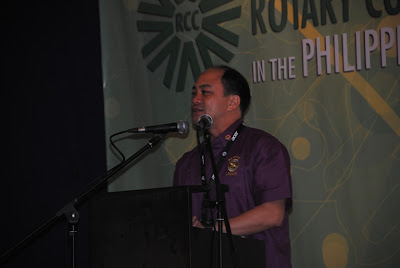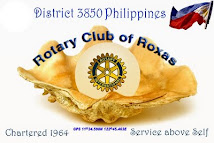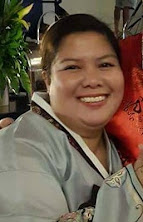
Hotel del Rio, Iloilo City August 24, 2011
PP Jorge G. Caparas
Trustee, RCC Foundation,Inc.
It is a pleasure for me to be here with you today since Iloilo has a special place in my heart- My wife is Ilongga, and my mother is half-Ilongga, with roots still in La Paz. So, let me try my little Visayan : Maayong hapon sa inyo nga tanan!
It is a great honor for all of us to have the Incoming Rotary International President Sakuji Tanaka San and Lady, Kyoko San to be with us. They have been with us in all of RCC’s 3-day Roadshow in Makati, Iloilo and Bulacan. I say to them for all of us: Arigato Gozaimashita!
We are here to learn more about what constitutes an effective service project involving the Rotary Community Corps.
Each person in this room has the most basic resource : human capital. Each of us is blessed with Time, Talent & Treasure.
We also possess human assets which we often harness- that is the ability to participate, mastery of local knowledge or traditions, entrepreneurial experience, training and educational experience, civic or community-based experience, talent & ideas, enthusiasm and energy.
When Paul Harris delivered a message to the delegates of the 1934 R.I. Convention in Detroit,Michigan, he stated : “As long as the grass continues to grow green, as long as water continues to flow downhill, so long Rotary will continue to worship its ideal of service.” The maxim “ Service Above Self” was conceptualized that day.
The purpose of RCC is to promote grassroots self-help projects, develop local leadership abilities, maximize local resources and use appropriate cost-effective technology.
When it was introduced to the Rotary world, RCC was envisioned to be an auxiliary to the sponsoring Rotary Club . The RCCs , however, should run their own affairs, make their own plans, decide what projects to undertake and to furnish their own manpower, administration and care necessary to bring those projects to completion.
In giving that kind of autonomy to the RCCs, the members derive pride in their membership and would lead to truly remarkable service projects.
There are 5 steps to implement an effective service project : select a project, plan a project, public relations, raise funds and evaluate success.
We can find Rotary manuals that will help us gather suggestions for implementing effective service projects. There are publications that are available to help in the training of RCC leaders & members , such as the following:
1. A Menu of Service Opportunities
2. Effective Public Relations : A Guide for Rotary Clubs
3. RCC Handbook
4. RCC Brochure
The characteristics of an effective RCC project are:
1. Responds to real issues and needs
2. Aims for specific goals & objectives with measurable results
3. Based on a realistic assessment of available resources
4. Improves community members’ lives
5. Recognizes the contributions of all participants as important & necessary
6. Builds effective networks
7. Empowers people & communities
Successful RCCs have many beneficial results:
1. Members foster unity, camaraderie, fellowship and morale
2. Members are involved in projects
3. Members can earn from the projects but the net proceeds must be set aside for community service projects
4. Members are happy with the improvement in their lives, the Rotary assistance, but mainly through their own efforts.
In the original concept of the RCC, the most important ingredients for its success are:
a) it should serve the community
b) it should promote livelihood, self-help / recognition of the dignity and value of all useful occupations.
Another important element of successful RCC projects is that each RCC is responsible for planning, organizing, financing and supplying the manpower and creativity necessary for its activities.
In summary, RCCs goals are : Individuals should be encouraged to (1) take responsibility for the improvement of their community or village; (2) recognize the dignity of all useful occupations; and (3) mobilize self-help activities and collective work to improve quality of life. In other words, it should encourage the development of human potential to its fullest, within the context of the local culture and community.
A good example is the RCC of Barangay San Roque sponsored by the RCC Club of Cubao, Quezon City, District 3780.
To help reduce the rate of water-borne diseases like typhoid fever, diarrhea and the like, the RCC built a new water system for Juan Sumulong High School in Quezon City.
The system includes a jack pump , water tank and purification system that benefits some 3,000 students in the community.
The sponsoring club registered the project on the WCS Project Exchange and was supported by a grant from the Rotary Club of Spartanburg, South Carolina, U.S.A.
It is an opportune time to promote RCC in its 25th anniversary. As Mahatma Gandhi once said, : One must be the change you wish to see in the world.”
As has been said, to implement an effective service project, we should instill in them the 3 Rs- ROTARIZE, ROTIVATE & ROTARIANISM.
Since an RCC is a group of non-Rotarian men and women who share Rotarian’s commitment to service, they should be educated about Rotary’s ideals, inform them about the developments in Rotary, train them on project conceptualization and implementation, help them build a strong organization, leadership and partnering with other organizations and stewardship of the environment. This is what we call “ Rotarizing” an individual or a group.
To help them accomplish these goals, Rotarians should inspire RCC members to live by and live up to the ideal of service and give life to Rotary values. Ihayag, Isapuso, Isabuhay ang Rotary values . Declare, take to heart, and live Rotary values - in other words, “Rotivation”
“Rotarianism” is an amalgam of 2 previous traits. Simply put, it is instilling in the RCC members the ideals of Rotary : service and fellowship.
In the 1946 Rotary International Convention , Atlantic City, New Jersey, Paul Harris said “ Rotary prolongs the life of hundreds of thousands of men. Rotary makes for health and happiness….Through it all there is a benign influence of fellowship which sweetens life”.
He further stated that , “ To be a good Rotarian, one should be a good neighbor, a kind friend, a loving husband, a companionable father, and an asset to the community where he lives.”
A Rotarian’s business is concerned with the global economy - businesses’ ability to market products and services all over the globe, develop partnerships and alliances throughout the world. These are all essential for business success in today’s fast growing and changing global economy.
On the other hand. RCC’s business is characterized by a democratic organizational structure with its members participating in decision making. Its emphasis is on job creation. However, it is supported by important volunteer resources particularly in the delivery of services.
As my father, Past Rotary International President M.A.T. Caparas have said in a message to this year’s Annual Conference of RVC Foundation Trustees and District RCC Chairpersons, where he touched upon the topic of Peace and Development, “ RCCs should not hesitate to start small, or to start with small projects. Such projects although small and benefiting only a tiny part of the population or the country, redound, however, minutely, to the benefit of the world and of all mankind. Small achievements are at least as meritorious as unsuccessful heroic efforts at grandiose goals… The Philippines is part of the world, such that the good things you do in the Philippines are actually good things done to the world.”
Thus, let us all learn from the wisdom of the pillars of Rotary so RCC can become a significant player in the social economy now and in future generations to come.
These are, I think, excellent guides for RCC work. We do not usually talk of world peace at the RCC level. However, there can be no world peace for as long as people are hungry, unhappy and desperate for change. You, my friends will make that big change! Good luck!
Thank you very much! Domo Arigato Gozaimasu! Madamo guid nga salamat!
 s of humanitarian service efforts with compassion and a commitment in providing long-term, sustainable solutions. With this, about more than 300 Rotarians from District 3850 (Zamboanga, Negros, Panay Island, Guimaras and Antique) and District 3860 (Cebu, Davao, Dumaguete, Bohol and Leyte) have gathered during the celebration of 25th Silver Anniversary of the Rotary Community Corp (RCC) in the Philippines last August 24, 2011 at Hotel Del Rio, hosted by the Rotary Club of Metro Iloilo led by Past District 3850 Governor, Ramon “Toto” Cua Locsin. The seminar is in cooperation with Philippine College of Rotary Governors (PCRG) and Rotary Village Corps Foundation, Inc. (RVC).
s of humanitarian service efforts with compassion and a commitment in providing long-term, sustainable solutions. With this, about more than 300 Rotarians from District 3850 (Zamboanga, Negros, Panay Island, Guimaras and Antique) and District 3860 (Cebu, Davao, Dumaguete, Bohol and Leyte) have gathered during the celebration of 25th Silver Anniversary of the Rotary Community Corp (RCC) in the Philippines last August 24, 2011 at Hotel Del Rio, hosted by the Rotary Club of Metro Iloilo led by Past District 3850 Governor, Ramon “Toto” Cua Locsin. The seminar is in cooperation with Philippine College of Rotary Governors (PCRG) and Rotary Village Corps Foundation, Inc. (RVC).

 words – RCC is about empowerment, generosity and respect. “All Rotary clubs around the Philippines develops projects through RCC that unite and empower the community at the grassroots level, and improve their quality of life as a whole, “ Dela Serna reiterated.
words – RCC is about empowerment, generosity and respect. “All Rotary clubs around the Philippines develops projects through RCC that unite and empower the community at the grassroots level, and improve their quality of life as a whole, “ Dela Serna reiterated.
 Topic 5 – Effective Service Projects with RCC by PP Jorge Caparas, Trustee, RVC Foundation, D3830.
Topic 5 – Effective Service Projects with RCC by PP Jorge Caparas, Trustee, RVC Foundation, D3830.




















































